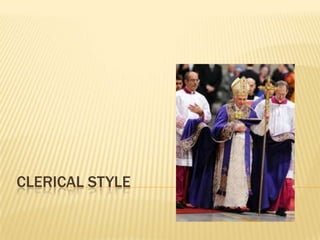
Clerical Vestments: A Guide to Liturgical Garb
- 2. VESTMENTS “Vestment” from the Latin, meaning clothing: any garments that are worn by the ministers of religion in the performance of their sacred duties. Vestments: both a uniform of the priest while “on duty” and theologically speaking, a sacramental. When “off duty” the term for a priest’s clothes is “clerics”. Historically, vestments were ordinary garments of the ancient Roman world. While the fashions of dressing changed with the passing centuries, priests continued to wear at the altar the ancient Roman costume of their predecessors, a witness to the historical continuity of the Catholic Church with the primitive Church of Rome.
- 3. ALB The alb is a long, white linen liturgical vestment with tapered sleeves. It is a garment (or robe) that is worn by the priest during the Holy Mass. It symbolizes the innocence and purity that should adorn the soul of the priest who ascends the altar.
- 4. CASSOCK The cassock, also known as a soutane, comes in a number of styles or cuts. Usually has 33 buttons (symbolic of the years of the life of Jesus) down the front. The ordinary cassock is black and worn by most clerics. Honorary prelates have
- 5. CHASUBLE The chasuble is the vestment that is put on over all the others during Liturgical services. Originally this was a very full garment, shaped like a bell and reaching almost to the feet all the way round. During a bad artistic period, the 18th and 19th century especially, the Chasuble suffered much from a process of shortening and stiffening. Today there is a return to the historical, draping
- 6. SURPLICE The surplice is a knee-length, white vestment worn over the cassock. It is typically simple in design, but can be very fancy.
- 7. STOLE Roman magistrates wore a long scarf when engaged in their official duties, just as judges wear a court gown today. Whenever a priest celebrates Mass or the Sacraments, he wears the stole as a sign that he is occupied with an official priestly duty. When placing the stole about his neck, in vesting for Mass, he
- 8. ZUCCHETTO The zucchetto is the silk skullcap worn by the Catholic clergy. It is white for the Pope, scarlet for a cardinal, and violet for a bishop. Priests may use a black cloth zucchetto for everyday wear, but not during the liturgy.
- 9. PALLIUM The pallium is only worn by archbishops, patriarchs, a nd the Pope, as symbol of the authority of a metropolitan. It is a thin band of white wool worn around the neck with extensions front and back. It has black crosses on it, and is pinned to the chasuble in three places around the neck. The lambs whose wool is destined for the making of the pallia are solemnly presented at the altar by the nuns of the convent of Saint Agnes. These same nuns later weave the pallia.
- 10. SANT’ AGNES FUORI LE MURA
- 11. MITRE The mitre is the common headdress of bishops, worn at liturgical functions. It is either precious, golden (orphreyed), or simple (simplex). The precious mitre is worn by celebrants, the simple by concelebrants, and the golden by the celebrant at an ordination. All cardinals wear a damasked mitre (simplex) in presence of the Pope. It is very tall, and is made of layered white damask silk.
- 12. AND HATS…
- 13. AND SOCKS AND SHOES!
- 14. Gammarelli’s (est. 1879, near the Pantheon): oldest and official store for Cardinal’s robes. Mar Statue Sacre (near Vatican)
- 15. DISTURBING (TO ME): CALENDARIO ROMANO CALENDARIO ROMANO 2011